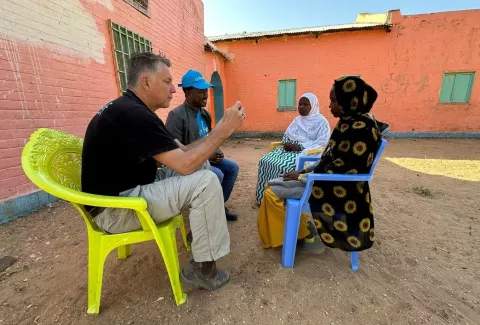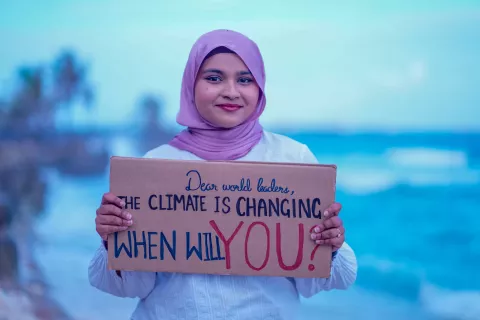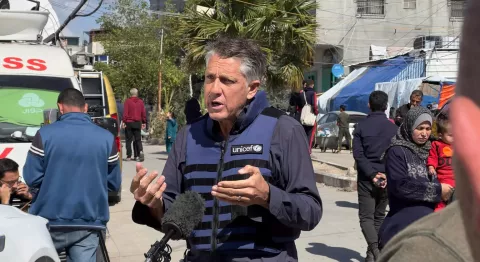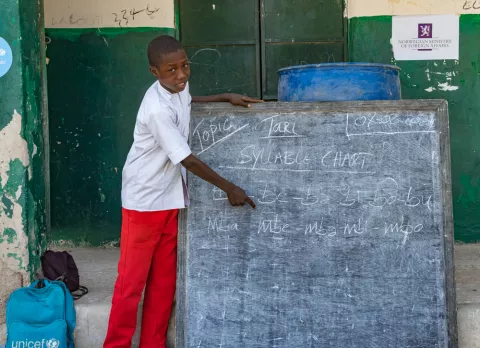At the start of 2024, we stand at a critical juncture: Geopolitical tensions are escalating, economic integration is unravelling, and multilateral cooperation is faltering. This global fragmentation threatens to undermine decades of progress made for children worldwide. The choices we make today – whether to continue on this path or whether we should bolster global cooperation – will have a profound impact on generations to come.
Children are always the most vulnerable in times of crisis – a reality highlighted by the COVID-19 pandemic, when school closures, economic hardship and disrupted health services jeopardized children’s rights and wellbeing. Almost four years since that pandemic was declared, our new report, Prospects for Children in 2024: Cooperation in a Fragmented World, paints a concerning picture for children’s future development and welfare.
Tensions among major powers are rising and the threat of new conflicts emerging is high. Beyond the immediate physical dangers, children can experience lasting psychological trauma and violations of their basic rights. If military spending continues increasing at the expense of investments in healthcare, education and social protections, children’s development will be further compromised.
Meanwhile, economic fragmentation is widening disparities between countries. Restrictive trade policies and supply chain disruptions are leading to rising energy and food prices, reducing access to essential goods and negatively impacting child nutrition and household incomes. Competition for critical minerals essential for the green economy is increasing the risks of trade fragmentation while threatening the pace of the green energy transition. At the same time, the drive to expand mining for minerals puts mining communities and children at risk of exploitative practices.
Despite continued global economic growth, the lukewarm and uneven recovery is diminishing prospects for reducing child poverty. From now until 2030, 15 million more children a year will be living in poverty than would have otherwise, due to the unequal post-COVID recovery.

This gloomy picture is compounded by the weakening of multilateral institutions, which is further undermining the potential for progress for children. Why? Because a fragmented multilateral system that is hamstrung by competing interests will struggle to deliver on conflict prevention, climate change, effective digital governance, debt relief and enforcing child rights standards, fuelling dissatisfaction in the Global South with rising inequalities. Children in the poorest nations also face continued barriers to financing for basic services. Crippling debt, high remittance fees and lack of voice in global economic governance restrict investments in healthcare, education and social protections – investments vital to children’s survival and development.
But amid all these concerning trends, we see still signs of hope. Alternative alliances are emerging in the developing world to advance cooperation, bringing novel policy solutions, more nimble policymaking and effective results. Despite expressing discontent with current democratic political structures, young people remain optimistic that opportunities exist to reform and resolve deficiencies in the political system, whether at the national or international level. They are engaging as change-makers, breathing new life into civic participation and democratic renewal.
In addition, technological innovations are unlocking new opportunities to empower children and enhance their rights. Green transition, if carried out in a just and sustainable way – one that prioritizes young people’s needs, skills and access to jobs in emerging sectors (such as the digital and green economy) – can benefit younger generations. Reforms and modernization of global governance and financing arrangements could still deliver greater justice for developing countries.
This more hopeful path will not unfold on its own. It requires global leaders to make an active choice – to double down on solidarity, inclusion and cooperation despite tensions and instability.
Prioritizing children and their rights must be at the centre of this choice.
Jasmina Byrne is Chief, Foresight & Policy, UNICEF Innocenti – Global Office of Research and Foresight.
To read more about what’s in store for children in 2024 and explore the eight trends that will impact them the most, please read Prospects for Children in 2024: Cooperation in a Fragmented World, the latest in UNICEF Innocenti’s annual Global Outlook series.





